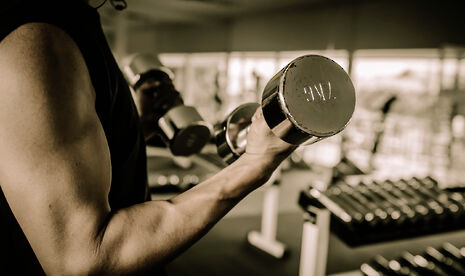Chasing Adonis: the male body-image epidemic
A toxic mixture of gym culture, unattainable Hollywood body ideals, and a shifting conception of the ‘perfect’ male physique is causing male anxiety over body-image, writes columnist Sam Brown

Rewind to 1966. The first of episode of Batman is about to air. You stare in anticipation as the screen cuts to the eponymous hero. The sight you are greeted with is almost comical to the modern viewer: the pot-bellied, flat-chested actor Adam West playing the Dark Knight stands resplendent in his tight grey suit and black cape, the epitome of the averagely-built man. Cast your eyes back to the present and Ben Affleck’s 2016 reinterpretation of the Batman franchise in Batman v Superman: Dawn of Justice. Here, Affleck’s Batman offers a markedly different physique. He stands at six foot four inches, weighs over one-hundred kilograms, and has a body-fat percentage of just seven percent. This simple comparison highlights how drastically society’s perception of the ideal male physique has morphed in the last fifty years. In our aesthetically grounded world, muscularity now equals masculinity.
The danger of these extreme portrayals of the ‘ideal’ male body is that for us mere mortals a superhero physique is ultimately unattainable. In order to pack on the 20 kilograms needed for the Batman role, Affleck went through a gruelling 15-month training programme, spending nearly every day in the gym – more time, in fact, than he spent rehearsing for the film itself. For him, attaining a muscle mass worthy of his character’s role is a central part of his day job. Non-Hollywood superhero actors – i.e. the rest of humanity – simply don’t have the time for such training, and yet they are still forced to view themselves relative to these Adonic figures. As Hollywood actors like Affleck become more muscular, normal men with normal bodies are growing less satisfied with their body image, and this has had severe consequences for male mental and physical health.
Body-image issues often start at a young age. A study published in JAMA Pediatrics examined more than 5,500 teenage boys in the US, and found that 18 percent had become “extremely concerned with their weight and physique.” In turn, more than seven percent of older teens were found to be using creatine supplements, growth hormone derivatives, or anabolic steroids to boost their muscle growth. Hormonal manipulation and the use of steroids are clearly dangerous practices, with heart failure, liver cancer, and infertility all potential side effects. These dangers are magnified when the user is still only a developing teenager.
“The only way to counter this crisis of body image anxiety is through open discussion – not just of muscle dysmorphia, but of all aspects of body image anxiety.”
Part of the problem lies in how little emphasis is placed on muscle-related body image anxieties in health institutions and society more generally. Quite rightly, the NHS allocates a lot of resources to the treatment of anorexia in both teens and young adults, but far less emphasis is placed on the effective opposite: obsessive muscle gaining behaviour. Indeed, the contrast in attitudes is culturally embedded. If a teen suddenly begins to drastically lose weight, parents and doctors will hopefully notice and provide appropriate help. However, a teenage boy going to the gym and packing on muscle is often viewed by society as relatively harmless, indeed even a natural pathway to adult masculinity. In short, addictive weight training practices have become normalised in a society that idolises the wide shoulders, large chests, and thin torsos of Hollywood male actors.
At the extreme of muscle-related anxieties is ‘muscle dysmorphia’, colloquially known as ‘bigorexia’. This anxiety disorder can cause both men and women to see themselves as physically smaller than they are, even if they have relatively large muscles. The condition is surprisingly common. Rob Willson, chair of the Body Dysmorphic Disorder Foundation, states that: “We know about 10% of men in the gym may have muscle dysmorphia.” Wilson adds that men are increasingly conditioned to believe that with a muscular physique come power, success, and attractiveness.
The stories of people who suffer from muscle dysmorphia are often deeply troubling and raise pertinent questions about how different genders feel they are supposed to act and what they physically should look like. “I always feel small,” a 25-year-old bodybuilder told the BBC for a story on ‘Bigorexia’. Staring endlessly at himself in front of the mirror, he said he wonders, “How can anyone love or enjoy what is here? It boggles my mind because I myself don’t like what I’m seeing.”
Severe muscle dysmorphia such as this is an extreme example of the body image crisis facing millions of men today. Feelings of physical inadequacy manifest themselves due to the imaginary ideals forced upon us. Social media only worsens the problem: on the internet, we’re all celebrities in a vague sense of the word, and public attention on our appearance is constant. A picture could be taken of us at any moment and we therefore feel the ‘need’ to look our best constantly.
The only way to counter this crisis of body image anxiety is through open discussion – not just of muscle dysmorphia, but of all aspects of body image anxiety. Candid discussion could encourage men and boys to start prioritising health over aesthetics, and start favouring their natural physiques over the excessively muscular bodies of Chris Pratt, Ben Affleck, and the like. Only then can we begin to counter the muscularity-masculinity complex and once again idolise the natural, realistic, and ever-so-slightly podgy superhero physiques of the 1960s
 News / SU stops offering student discounts8 January 2026
News / SU stops offering student discounts8 January 2026 News / Uni-linked firms rank among Cambridgeshire’s largest7 January 2026
News / Uni-linked firms rank among Cambridgeshire’s largest7 January 2026 Comment / Plastic pubs: the problem with Cambridge alehouses 5 January 2026
Comment / Plastic pubs: the problem with Cambridge alehouses 5 January 2026 News / New movement ‘Cambridge is Chopped’ launched to fight against hate crime7 January 2026
News / New movement ‘Cambridge is Chopped’ launched to fight against hate crime7 January 2026 Comment / What happened to men at Cambridge?31 December 2025
Comment / What happened to men at Cambridge?31 December 2025









